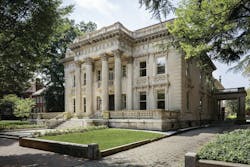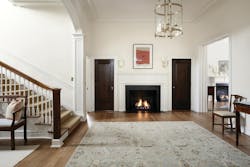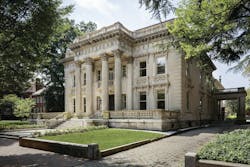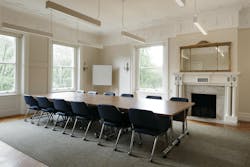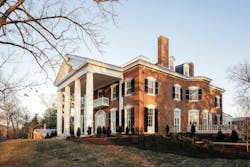Explore most university campuses and you’ll encounter a wide array of buildings that serve an even broader variety of functions. Managing the diverse and complex set of facilities on campus is a daunting challenge. One type of building frequently proves particularly complex: historic homes.
Many colleges and universities own historic, often grand, homes on or adjacent to campus and pre-date the founding of the school. Whether they have been purchased or bequeathed, their history is tied to that of the academic institution.
These historic homes may offer exciting opportunities, especially if they are rehabilitated and updated in a way that preserves their character-defining features while reinvigorating them for the needs of a modern school.
Each campus has its own unique identity and needs, but broadly, the thoughtful rehabilitation of historic residential properties can provide functional and appealing resources in three primary ways.
Dual-purpose homes
Perhaps the most common use of historic homes on campus is to serve as residences for school presidents and their families. There are many benefits to having a president live on campus. Grand historic homes are an appealing and obvious option. Although these buildings were constructed as homes, the ways in which people live and learn today are quite different from generations ago.
A grand historic home with a generous floor plan may persuade a university to pursue dual purposes for the space. A president’s house may have public spaces for entertaining and events on the first floor and private spaces for presidents and their families on upper floors. Examples include Carr’s Hill at the University of Virginia in Charlottesville, the Mansion House at Hampton University in Hampton, Virginia, and the Superintendent’s Quarters at the Virginia Military Institute in Lexington.
A president’s house, especially a historic one, lends itself well to serving as a space to bring in visitors and host students. Important considerations for public access include ensuring that the first floor of the house is accessible to those with disabilities, from the front door to restroom facilities. Likewise, the furnishing of these public spaces should be intentional. Furnishings in these areas should be flexible and easy to move. Furniture on wheels or that can be easily lifted enables spaces to become more dynamic; multiple event arrangements can be carried out easily and quickly. Furniture in the front hall at Carr’s Hill has been moved out with relative ease to make room for a piano from the living room for an impromptu concert.
Durable fabrics are also crucial for long-term maintenance in these public access areas. With thoughtful selection, commercial-grade fabrics and carpets with stain- and rub-resistant qualities will be able to withstand high-traffic use while still retaining a residential feel.
When rehabilitating a historic home for dual uses, early conversations also should aim for spaces that will have considerable overlap, such as kitchens that can comfortably serve both a family’s needs and event catering. Areas for more informal family living and dining need to be incorporated into the first-floor design in addition to traditional, formal living and dining rooms.
In private family spaces, it’s important to balance the needs of a family with the long-term interests of the school. Without over-customizing, the private spaces should be designed to meet the needs of a family, while respecting the historic features from the past and future generations that will occupy the house.
Meeting and office space
Rehabilitating historic homes to serve as a venue for meetings, offices, or classrooms is another common approach. Early in the design and planning process, carefully study the floor plan and how it can meet program needs. For example, do room sizes make them more appropriate for a particular type of use? How do you want students or staff to engage with the building?
The Scott House at Virginia Commonwealth University (VCU) in Richmond offers insight on how early planning can guide the effective restoration of a grand home on campus.
In studying the building footprint and floor plan, VCU took the size of rooms into account as it decided what function they would serve. Smaller rooms, particularly on the second and third floors, were candidates to be converted into office space; larger spaces would become meeting rooms. A very large first floor room made an ideal classroom, which aligned with the school’s goal of drawing students to visit the beautiful historic structure. Updated MEP systems were concealed in cedar closets, an abandoned dumbwaiter provided a valuable vertical shaft for IT cabling, and a former trunk room was an ideal size for a break room. The most formal rooms on the first floor retained their original functions for entertaining visitors.
VCU effectively used the house’s floor plan to help the team determine the highest and best function for the spaces. By following the lead offered by the existing floor plan, the university incorporated the key historic features into the project.
Hospitality venues
Converting historic homes and grand estates into hospitality venues on or near campus is another option that has proven successful at many higher education institutions. Colleges and universities need hotel space and hospitality venues to host events and visitors.
Birdwood, a large evolved country house and grounds nestled in the foothills between Charlottesville and the Blue Ridge Mountains, was acquired by the University of Virginia Foundation, the university’s real estate arm. The property retains a high degree of historical integrity and stunning views. Its location—within easy reach of the university and next door to the Boar’s Head Resort—led to the decision for a light-impact approach in using the house as a hospitality venue. It is a continuation of the estate’s history and leveraged in a way that benefits the school as a financially self-supporting inn and event venue.
This large estate was a prime candidate for hospitality because bedrooms could be converted to hotel-style rooms and formal rooms were large enough to host a wide range of functions. Once the rehabilitation is complete, the estate can be rented for events, such as a wedding or family reunion, but also will include an exhibit design component so the history of the property is available to everyone. A major design challenge for Birdwood was the installing an elevator to provide public accessibility to all floors.
The three uses outlined can be found on campuses across the country. By thoughtfully considering the floor plan, highlighting character defining historic features, and building in flexibility and accessibility, a historic home can provide important services for a school’s needs while ensuring the structure’s historic significance can be enjoyed for future generations.
Sidebar: 3 considerations for historic homes
Research and plan early: Thoughtful research and planning are paramount when working with historic homes. Create historic integrity diagrams and research character defining features to help you make informed design decisions.
Add extra time: There are always surprises with historic buildings. Allot extra time to the design and construction schedule. For example, code coordination often results in unexpected delays.
Consider exhibit space: Historic homes are an ideal opportunity to provide context to the home and campus. Find ways to provide educational moments by adding exhibit displays or spaces in public areas of a home.
About the Author
Susan Reed
Susan Reed, AIA ([email protected]) is a principal and director of historic preservation at Glavé & Holmes Architecture in Richmond, Virginia. She has worked on projects for colleges and universities throughout the Mid-Atlantic.
